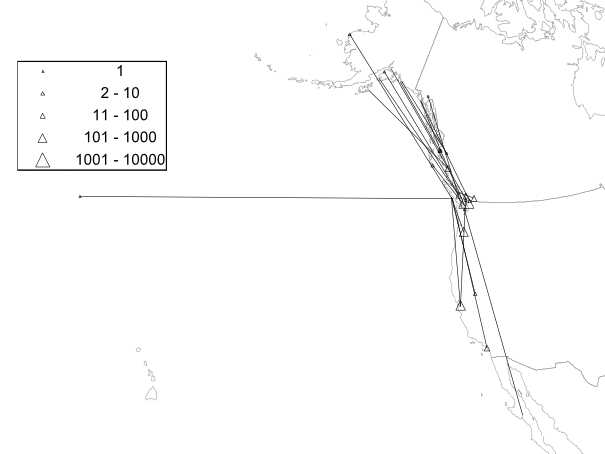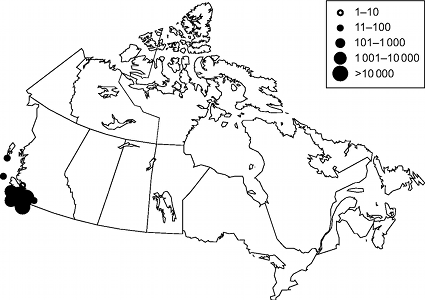|
|||||||||||||||||||||||||||||||||||||||||||||||||||||||||||||||||||||||||||||||||||||||||||||||||||||||||||||||||||||||||||||||||||||||||||||||||||||||||||||||||||||||||||||||||||||||||||||||||||
Coordinators: 1cy July 2cy Jan 3cy Jan 4cy / sub-ad Jan adult Jan |
Ringing, banding, wing-tags, metal & plastic bandsCanadian Atlas of Bird Banding Volume 2: Seabirds, 1921–1995. (Gaston et al., 2008)Glaucous-winged Gull (Larus glaucescens) 44.0
Encounters: Glaucous-winged Gull (block size = 7.6°)
Substantial banding effort, concentrating on nestlings, in a number of colonies in British Columbia for many years has produced enough encounters for several analyses (Woodbury and Knight 1951; Pearse 1963; Butler et al. 1980), which are the basis for this account. Butler et al. (1980) excluded sight records (band numbers read through binoculars or telescope), which account for over half the encounters of this species, due to the activities of several dedicated individuals (see, for example, Houston 1963). Banding effort on this species decreased sharply after 1975. The species has the highest encounter rate of any Canadian seabird (9% of those banded have been reported). Butler et al. (1980) found that first-year birds were encountered mainly between September and November, substantially earlier than the peak of December–February reported in an earlier study (Woodbury and Knight 1951), based on birds banded from 1938 to 1940. Butler et al. (1980) suggested that this shift in the timing of mortality may have been due to increased competition with adults because of the rapid increase in numbers that took place subsequent to the earlier study (estimated at 3.5-fold between 1928 and 1974). Older immatures were encountered more evenly through the year, but adults (4 years and older) were encountered most frequently in July and August. The mortality of first-year birds was estimated from band returns as 58–59%. Most encounters showed a southerly dispersal away from the breeding colonies in autumn (records 1 and 2). Butler et al. (1980) felt this trend was real, in spite of the bias introduced by the distribution of human populations, being predominantly to the south of most colonies. However, there are several hundred sight records in British Columbia of birds banded in colonies in Washington State, all of which show northward movement (many of 100 km or more, although, of course, only northward movements are possible for U.S.-banded birds encountered in Canada!), suggesting a much more random pattern of post-fledging dispersal. One encounter of a secondyear bird at Prince Rupert involved a northward movement of 800 km (record 3). The rate of autumn dispersal was estimated from band returns as about 350 km per month — to wintering grounds in Washington, Oregon, and central California (mainly in December–March); this pattern is strongly biased by the distribution of major cities. Not only are banded Glaucous-winged Gulls more likely to be encountered in cities, but the gulls also concentrate there to feed on refuse dumps (Cogswell 1977). Butler et al. (1980) found no difference in the distances moved by different age groups, although Woodbury and Knight (1951) had found that first-year birds moved farther away than older individuals. Even in December, nearly 40% of encounters were within 100 km of the banding site, suggesting that a substantial part of the population is resident. Vermeer (1963) found that individuals tended to return to traditional sites in successive winters. Among a small sample of birds banded in Alaska and encountered (mainly as sight records) in British Columbia (records 4 and 5), encounters were chiefly in nter (73% between December and February), with only one in summer. Glaucous-winged Gulls are coastal birds, and the pattern of encounters reflects this. The recovery files include several encounters showing movement far inland and to the east of the normal range; unfortunately, Glaucous-winged Gulls take the same band size as Mallards Anas platyrhynchos and these encounters may have arisen from band numbers being misread. We have excluded all records east of 110°W. However, the Glaucous-winged Gull is a "fairly frequent visitor to the N.W. Hawaiian Islands" (Pratt et al. 1987) and to Japan (Brazil 1991), so there seems no reason to doubt the authenticity of records 6 and 7, the first of which was of a bird recaptured by a bander. The encounter in Yukon (record 8) would, if genuine, constitute only the second record for the Yukon (Godfrey 1986). However, the encounter code (98) indicates that only the band or band number was reported, without any supporting details; consequently, this recovery has to be regarded as incompletely authenticated. Like other large gulls, Glaucous-winged Gulls can live a long time. The North American record of 22 years and 1 month reported by Clapp et al. (1982) is now exceeded by a bird banded as a nestling at Mitlenatch Island, B.C., and encountered in California at 23 years and 5 months (record 9). However, Campbell et al. (1990b) reported several individuals, identified by plumage characteristics and habits, that lived more than 25 years.
Banding effort: Glaucous-winged Gull
|
Glaucous-winged Gull glaucescens | |||||||||||||||||||||||||||||||||||||||||||||||||||||||||||||||||||||||||||||||||||||||||||||||||||||||||||||||||||||||||||||||||||||||||||||||||||||||||||||||||||||||||||||||||||||||||||||||||
 Glaucous-wingedGull glaucescens F50 pre-basic moult 1st > 2nd cycle (2CY), August 03 2016, Sitka, AK. Picture: Connor Rowan. Glaucous-wingedGull glaucescens F50 pre-basic moult 1st > 2nd cycle (2CY), August 03 2016, Sitka, AK. Picture: Connor Rowan. |
|||||||||||||||||||||||||||||||||||||||||||||||||||||||||||||||||||||||||||||||||||||||||||||||||||||||||||||||||||||||||||||||||||||||||||||||||||||||||||||||||||||||||||||||||||||||||||||||||||
 Glaucous-winged Gull glaucescens H42 1st cycle (2CY), February 09 2016, Esquimalt Lagoon, Colwood, BC. Picture: R. Hardy. Glaucous-winged Gull glaucescens H42 1st cycle (2CY), February 09 2016, Esquimalt Lagoon, Colwood, BC. Picture: R. Hardy. |
|||||||||||||||||||||||||||||||||||||||||||||||||||||||||||||||||||||||||||||||||||||||||||||||||||||||||||||||||||||||||||||||||||||||||||||||||||||||||||||||||||||||||||||||||||||||||||||||||||
| Olympic Gull glaucescens x occidentalis | |||||||||||||||||||||||||||||||||||||||||||||||||||||||||||||||||||||||||||||||||||||||||||||||||||||||||||||||||||||||||||||||||||||||||||||||||||||||||||||||||||||||||||||||||||||||||||||||||||
Band Number |
Sex |
Distance |
Duration |
Banding |
Encounter |
||||||||||
|---|---|---|---|---|---|---|---|---|---|---|---|---|---|---|---|
Who Banded |
Age |
Day |
Location |
Latitude |
Longitude |
Day |
Location |
Latitude |
Longitude |
Condition |
How Obtained |
||||
| 0867-84563 | U | 808 km N50°W | 1 yr. 11 mo. | BCPM | L | 19/07/73 | Cadboro Bay, BC | 48°20'N | 123°10'W | 16/06/75 | near Prince Rupert, BC | 54°10'N | 130°10'W | 7 | 52 |
| 0396-52467 | U | 1222 km S4°E | 5 mo. | DAH | U | 03/08/39 | Imrie Island, BC | 48°40'N | 123°10'W | 22/01/40 | Alcatraz Island, CA | 37°40'N | 122°20'W | 0 | 97 |
| 0587-02707 | U | 6859 km S88°W | 2 yr. 3 mo. | DAH | L | 29/07/56 | Gulf Islands, British Columbia | 48°20'N | 123°10'W | 81/10/58 | at sea off Hokkaido, Japan | 42°0'N | 144°0'E | 0 | 26 |
| 0527-27190 | U | 1568 km N48°W | 8 yr. | EDW | L | 27/08/54 | near Seagull Island, BC | 48°10'N | 123°30'W | 99/93/62 | near Rancheria, YT | 60°0'N | 130°50'W | 0 | 98 |
| 0586-88077 | U | 2042 km S69°E | 10 mo. | FSW | L | 20/07/64 | Homer, AK | 59°30'N | 151°30'W | 02/05/65 | Lasqueti Island, BC | 49°30'N | 124°30'W | 5 | 0 |
| 0646-89489 | U | 2141 km N64°E | 2 yr. 4 mo. | LJP | AHY | 06/05/61 | Anchorage, AK | 61°10'N | 149°50'W | 30/09/63 | Vancouver, BC | 49°10'N | 123°0'W | 0 | 87 |
| 0857-69437 | U | 1692 km S21°E | 1 yr. 0 mo. | RWC | L | 05/08/70 | Cleland Island, BC | 49°10'N | 126°0'W | 18/08/71 | Lompoc, CA | 34°30'N | 120°20'W | 3 | 0 |
| 0587-37304 | U | 4938 km S82°W | 4 yr. 4 mo. | RWC | L | 22/07/67 | Tofino Inlet, BC | 49°0'N | 125°40'W | 04/12/71 | Midway Island, HI | 28°10'N | 177°20'W | 7 | 89 |
| 0807-33407 | U | 1329 km S8°E | 23 yr. 5 mo. | RWC | L | 02/08/69 | Mitlenatch Island, BC | 49°50'N | 125°0'W | 20/01/93 | near San Fransisco, CA | 38°0'N | 122°50'W | 5 | 0 |
 Glaucous-winged Gull glaucescens
Glaucous-winged Gull glaucescens
